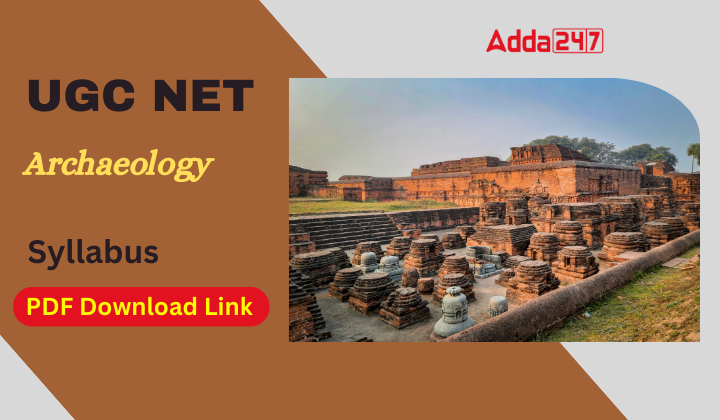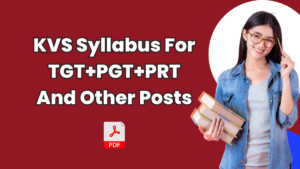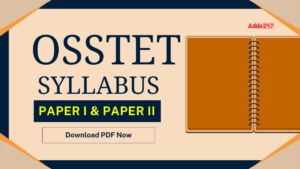Table of Contents
UGC NET Archaeology Syllabus 2025 has been released on the official website. The UGC NET Archaeology syllabus 2025 comprises two papers, addressing teaching and research aptitude in Paper 1, while Paper 2 focuses specifically on Archaeology. UGC NET Archaeology syllabus Paper 2 delves into the study of Archaeology and recent trends in archaeology. This comprehensive article contains the UGC NET Archaeology Syllabus 2025 PDF has been provided below.
UGC NET Archaeology Syllabus 2025
The UGC NET Archaeology syllabus 2025 encompasses a broad spectrum of topics essential for understanding the discipline, spanning prehistoric, protohistoric, and historical periods. It includes the study of human evolution, Stone Age cultures, the Harappan civilization, urbanization, excavation techniques, museology, conservation, and recent trends in archaeology.
UGC NET Archaeology Exam Pattern
UGC NET Syllabus for Archaeology has been released and is available in article below. The UGC NET Archaeology exam is conducted by the National Testing Agency (NTA) twice a year. It is a computer-based test (CBT) that consists of two papers: Paper 1 and Paper 2.
Paper 1: Teaching and Research Aptitude
- Total Marks: 100
- Total Questions: 50
- Duration: 1 hour (60 minutes)
- Nature of Questions: Objective type, multiple-choice questions
- Topics Covered: Teaching aptitude, research aptitude, reading comprehension, communication, reasoning, logical reasoning, data interpretation, information and communication technology (ICT), and people and environment.
Paper 2: Archaeology
- Total Marks: 200
- Total Questions: 100
- Duration: 2 hours (120 minutes)
- Nature of Questions: Objective type, multiple-choice questions
- Topics Covered: Prehistoric Archaeology, Protohistoric Archaeology, Historical Archaeology, Methods and Techniques in Archaeology, Museology and Conservation, Archaeological Heritage of India, and Recent Trends in Archaeology.
UGC NET Archaeology Paper II Important Topics
The UGC NET Archaeology Syllabus 2025 Paper II Important Topics are comprehensive and covers various aspects of archaeological study. Here’s a breakdown of the key areas you’ll encounter:
- Prehistoric Archaeology
- Protohistoric Archaeology
- Indus Valley Civilization
- Archaeological Sites in India
- Dating Methods in Archaeology
- Cultural Ecology
- Conservation and Heritage Management
- Ethnoarchaeology
- Rock Art and Petroglyphs
- Epigraphy and Numismatics
UGC NET Archaeology Syllabus for Paper II
The UGC NET Archaeology Paper II syllabus covers a wide range of topics related to archaeological theory, methods, and findings, with a particular focus on India. Here’s a breakdown of the key areas:
Unit 1: Introduction to Archaeology
- Definition, aims, scope, and ethics of archaeology; history and growth of Archaeology. History of Indian archaeology.
- Relationship of archaeology with social and natural sciences. Type and nature of archaeological data.
- Retrieval of archaeological data
- Methods of artefact analysis
- Preparation of archaeological reports.
- Conservation and preservation of archaeological remains/sites: Aims and Methods; Antiquarian laws.
- Chronology and Dating Methods
Unit 2: Introduction to Prehistory
- Prehistoric beginning: Geological, biological, and cultural dimensions of humans. Human origin and the Geological time scale
- Biostratigraphy of the Pleistocene
- Main stages of human evolution and important fossil records
- Cultural backdrop
- Palaeolithic Cultural Development in the World Context:
Unit 3: Palaeolithic Cultural Developments in the Indian Subcontinent
- Geo-chronology and Stone Age cultures of India
- Lower Palaeolithic culture
- Middle Palaeolithic culture and geographical spread; Tool types and lithic technology of the Middle Palaeolithic: the prepared core techniques/Levallois technique.
- The Upper Palaeolithic culture
- Prehistoric Art in the Indian context
Unit 4: Mesolithic and Neolithic Cultures
- Mesolithic in Europe; Epi-Palaeolithic developments in West Asia Neolithic and Food Production: Neolithic stage in West Asia and China.
- Mesolithic culture of the Indian subcontinent: Characteristic features; Tool types and micro-blade technology; regional variations in tool assemblages; Evidence of incipient stages of food production. Patterns of ecological adaptation and distribution: Sites in the alluvial plains, horseshoe lakes, coastal sites, sand-dune sites, sites in the plateaus and rock-shelter sites.
- Neolithic cultures of the Indian subcontinent: Early farming communities of Baluchistan: Mehrgarh and Kili-Gul-Muhammad. Neolithic culture in Kashmir.
- Neolithic culture in the Central Ganga and Vindhyan region: Koldihwa, Mahagara, Lahuradewa etc. Eastern Neolithic sites: Chirand, Chechar Senuwar, Kuchai, and Baidyapur and the Neolithic culture of the North-Eastern region: Sarutaru, Selbalgiri, Daojali Hading, Marakdola.
- Neolithic cultural development in the southern peninsular India: Sanganakallu, Pikhlihal, Uttnur, Kodekal, Teklakota, Hallur, Nagarjunakonda and Ash-mound sites.
Unit 5: Proto-History
- Courses towards urbanization: The Harappa culture.
- Formative stages of the Harappa culture
- Early Harappan and the Emergence of the Urban Harappan Cultural Ethos:
- Post-Urban Harappan
- Other Chalcolithic Cultures of India:
Unit 6: The Iron Age
- The Iron Age and growth of new urban centres. Antiquity of Iron in India: Early stages of Iron Age, new evidence from Malhar, Dadupur, Raja Nal-ka-tila,
- Hallur, Kumaranahalli and Kodumanal.
- Painted Grey Ware culture: Extent, and Chronology and characteristic traits.
- Northern Black Polished Ware culture: Extent, chronology and characteristic traits.
- Iron Age in Peninsular India
- Emergence of Urban Centres
- Important Sites of Historical Period
Unit 7: Architecture
- Architecture: A significant source of Indian history
- The Stupa architecture: Structural Stupas: Origin and development: North and South Indian stupas.
- Development of Rock-cut architecture: Origin and Development – Buddhist Brahmanical and Jain.
- Temple Architecture
- Gupta, Chalukyan, Pallava and Rashtrakuta temples. Regional styles: Khajuraho temples, Temples of Odisha and Chola temples.
- Art and Iconography
- Sculptural Art
- Iconography
- Brahma, Vishnu, Shiva, Kartikeya, Ganesha, Surya, Shakti, Tirthankara (Rishabh dev, Parshvanath and Mahavira), Buddha, Bodhisattva and Tara.
- Terracotta Art: Mauryan to the Gupta period
- Paintings: Rock-cut cave paintings: Ajanta, Bagh and Sittanavasal
Unit 8: Palaeography and Epigraphy
- Epigraphy as a source of Indian history:
- Origin and antiquity of writing in India;
- Origin and development of Brahmi and Kharosthi scripts: Various theories.
- Study of selected inscriptions
Unit 9: Numismatics
- Numismatics: Coins as an important source of history Origin and antiquity of coinage in ancient India.
- Technique/Methods of manufacturing coins: Silver, copper, gold, and alloys.
- The main type of coins
Unit 10: Methodology of Archaeological Research
- Role and characteristics of research, research ethics, methods of research; case studies and field investigations; Hypothesis formulation and research design; data collection and processing: Primary and secondary sources, use of Information and Communication Technologies (ICT) in archaeological research; Methods of systematic referencing; Systematic presentation of data and results
Download UGC NET Archaeology Syllabus PDF
The direct link to download UGC NET Archaeology Syllabus has been provided below. Click on the below link to download UGC NET Archaeology Syllabus in Hindi and English.
| UGC NET Archaeology Syllabus | |
| Download UGC NET Archaeology Syllabus in English | Download UGC NET Archaeology Syllabus in Hindi |
UGC NET Archaeology Paper II Marking scheme
The UGC NET Archaeology Paper II follows a specific marking scheme. UGC NET marking scheme implies that each correct answer earns the candidate 2 marks, and there is no penalty for wrong answers. Therefore, candidates are encouraged to attempt all questions without fear of losing marks for incorrect responses.
- Total Marks: 200
- Total Questions: 100
- Each question carries: 2 marks
- Negative marking: There is no negative marking for incorrect answers.
UGC NET Minimum Archaeology Paper-II Qualifying marks
The minimum qualifying marks for UGC NET Archaeology Paper II (and Paper I) depend on your category. The minimum qualifying marks for UGC NET Archaeology Paper-II are determined based on several factors, including the difficulty level of the examination, the number of candidates appearing for the exam, and the overall performance of candidates.
- General Category (Unreserved): 40% (which translates to 40 marks out of 100 for Paper II).
- OBC Non-creamy Layer, PWD/SC/ST and Transgenders: 35% (which translates to 35 marks out of 100 for Paper II).
Uses of UGC NET Archaeology Paper II Syllabus
The UGC NET Archaeology Paper II syllabus serves several important purposes for candidates preparing for the examination:
- Guidance for Preparation: The syllabus provides a structured outline of the topics that candidates need to cover while preparing for the exam. It helps them organize their study materials and focus on the key areas of the subject.
- Understanding Exam Scope: By detailing the topics to be covered, the syllabus helps candidates understand the breadth and depth of the subject matter they need to be familiar with for the examination. It gives them a clear idea of what to expect in the exam.
- Targeted Study: Candidates can use the syllabus to identify their strengths and weaknesses in different topics. This allows them to prioritize their study efforts and allocate more time to areas where they need improvement.
- Resource Selection: With the syllabus as a guide, candidates can select appropriate study materials, textbooks, reference books, and online resources that align with the topics covered in the exam.
- Practice Planning: Candidates can use the syllabus to create study schedules and practice plans. They can allocate specific timeframes for studying each topic and practice answering questions related to those topics.
- Self-Assessment: The syllabus enables candidates to assess their progress periodically. They can evaluate their understanding of each topic by testing themselves with sample questions or mock tests based on the syllabus.
- Exam Strategy: Based on the syllabus, candidates can develop effective exam strategies. They can focus on topics with higher weightage, ensure thorough understanding of fundamental concepts, and practice time management skills to complete the exam within the allocated time.




 KVS Syllabus 2025 For PRT, TGT, PGT and ...
KVS Syllabus 2025 For PRT, TGT, PGT and ...
 CTET Paper 2 Syllabus and Exam Pattern 2...
CTET Paper 2 Syllabus and Exam Pattern 2...
 OSSTET Syllabus 2026, Check Exam Pattern...
OSSTET Syllabus 2026, Check Exam Pattern...












